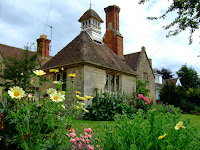 We went to bed with a thunderstorm raging and were woken at 2, 5 and 6 a.m. with flashes of lightning, peals of thunder and lashing rain. In between there was the roar of the swollen river as it rushed past our campsite and, when the rain let up, the ding-dong of the cowbells across the river. All in all, a good night’s sleep!
We went to bed with a thunderstorm raging and were woken at 2, 5 and 6 a.m. with flashes of lightning, peals of thunder and lashing rain. In between there was the roar of the swollen river as it rushed past our campsite and, when the rain let up, the ding-dong of the cowbells across the river. All in all, a good night’s sleep!When we finally climbed out of bed we found a stream running through the ‘front room’ of our tent and discovered that we had pitched our tent slap in the middle of the run-off path from the ground around and we were camped in 30mm of water. All credit to Ted Baker and his tent design team; we, and our gear inside the ‘living room’, were dry. With a team of helpers laid on, we unpegged and bodily shifted the erect tent to drier ground.
 It stopped and started, drizzled and fizzled but was dry enough for breakfast after which we drove down to Bourg St Maurice. The road up to this campsite and down to Bourg St Maurice will be transformed beyond recognition in a few days time when “The Tour’ sweeps through. The prospect of riding a racing cycle up or down these roads strikes terror into the heart. The riders must truly be mad.
It stopped and started, drizzled and fizzled but was dry enough for breakfast after which we drove down to Bourg St Maurice. The road up to this campsite and down to Bourg St Maurice will be transformed beyond recognition in a few days time when “The Tour’ sweeps through. The prospect of riding a racing cycle up or down these roads strikes terror into the heart. The riders must truly be mad. We attempted a walk up the valley to a cheese factory but the weather beat us back.
 By 4 p.m. it was actually quite clear, but the local forecast was for snow down to 1900m. Since our campsite was at 1560m that did not seem a large enough margin for error for our liking.
By 4 p.m. it was actually quite clear, but the local forecast was for snow down to 1900m. Since our campsite was at 1560m that did not seem a large enough margin for error for our liking.The majority of the party were keen to break camp and move on but our intrepid leader was sure that tomorrow was going to be a fabulous day and that we would, at last, be able to see the Alpes in all their splendour.
















 The village was having their annual fete on the green, and the whole place looked like a mocked up tourist attraction.
The village was having their annual fete on the green, and the whole place looked like a mocked up tourist attraction.






















